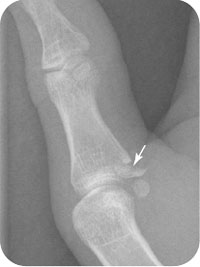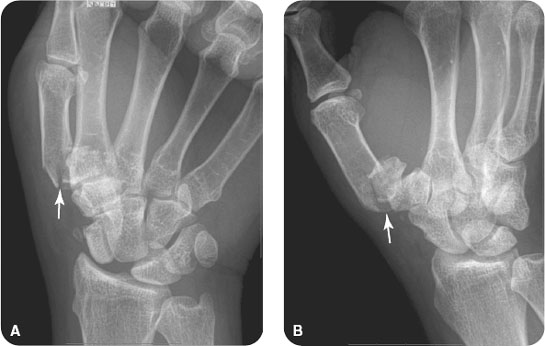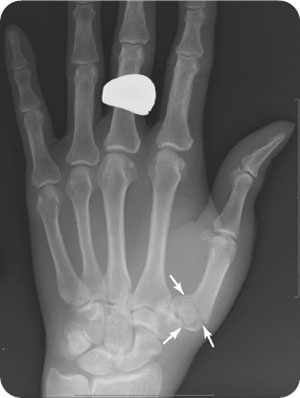George M. Bridgeforth, Brian Weatherford, and Charles Carroll IV
A 24-year-old man injures his right hand while wrestling with his brother. He complains of marked swelling, pain, and tenderness in his thumb, as well as limited range of motion.

CLINICAL POINTS
- A broken thumb affects a person’s ability to grasp.
- Sports activities may lead to thumb fractures.
- Using protective taping may reduce the risk of a thumb fracture.
Clinical Presentation
A broken thumb is a serious injury. It is especially critical because the opposable thumb, when working properly, allows humans to grasp and pinch. Thumb function accounts for as much as 50% of overall hand function, which in turn depends on an intact and functional joint at the base of the thumb. The bones in the thumb consist of two phalanges and a metacarpal (actually a primordial phalanx) (Fig. 48.1). The distal phalange runs from the tip of the thumb to the knuckle, and the proximal phalange runs from the knuckle to the base of the thumb. Although a fracture can occur in any of these bones, the most serious breaks occur near the joints. A fracture at the base of the thumb, near the wrist, may be especially problematic. A Bennett fracture is an oblique intra-articular fracture of the base of the first metacarpal bone that extends into the carpometacarpal (CMC) joint (Fig. 48.2). A Rolando fracture also involves a break at the base of the thumb, except that it is a comminuted fracture (Fig. 48.3).
The mechanism of injury in thumb fractures is usually an axial load (downward force), with the thumb in flexion or extension. Direct stress, such as from a fall, is often the cause. Hyperextension, flexion, and rotational injuries also occur. Indirect trauma may also lead to thumb fractures. People with a history of bone disease are also at risk. Victims are most likely to be males between 10 and 30 years of age. Injuries most often result from sports injuries (football, baseball, basketball) on weekends.
PATIENT ASSESSMENT 
- Marked pain, soreness, and swelling at the fracture site
- Pain and limited range of motion of the thumb
- A misshapen thumb
- Possible numbness or coldness in the thumb
The physician should examine the injury carefully and take a medical history. Severe pain and swelling at the site of the break are common in all types of thumb fractures. Characteristic signs of a Bennett or Rolando fracture include pain, swelling, and ecchymosis around the base of the thumb as well as instability of the CMC joint. During the examination, the physician should also check for open fractures (associated wounds). In addition, it is important to check neurologic and vascular status:
- Cold, dusky, cyanotic hand
- Decreased or absent pulses
- Numbness

FIGURE 48.1 Wrist and hand bones. Dorsal view. Asset provided by Anatomical Chart Co.

FIGURE 48.2 (A) Anteroposterior and (B) oblique radiographs of the right hand in a 55-year-old man involved in a motorcycle collision. These radiographs demonstrate an acute comminuted fracture of the base of the first metacarpal consistent with a Rolando fracture, which has a worse prognosis than the Bennett fracture.

FIGURE 48.3 A 68-year-old man presents with left thumb pain after falling. The AP radiograph of the left hand demonstrates a T-shaped fracture of the base of the first metacarpal with intra-articular extension compatible with a Rolando fracture.
Stay updated, free articles. Join our Telegram channel

Full access? Get Clinical Tree








